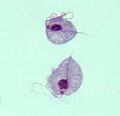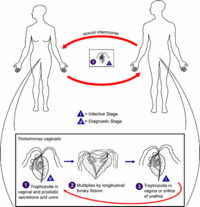Trichomonas vaginalis
| Scientific classification | ||||||||||||
|---|---|---|---|---|---|---|---|---|---|---|---|---|
| ||||||||||||
| Binomial name | ||||||||||||
| Trichomonas vaginalis |
Between 1934 and 1939,Trichomonas vaginalis was identified and classified by Procaccini, an Italian scientist, in Ethiopia. Little information is known of the discovery of Trichomonas vaginalis. Trichomonas vaginalis, a flagellated protozoan, is the causative agent of trichomoniasis belongs to the kingdom Archezoa. The members of this group, E. histolytica and G. lamblia, are parasitic protozoans that adhere to the host lumen, are fermenters (anaerobic respiration), and lack mitochondria. Instead of mitochondria they have a hydrogenosome that generate molecular hydrogen and produce ATP, among its many functions. All the members of Archezoa are multi-flagellated. In T. vaginalis five flagella are near the cytosome, four of which extend outside the cell together. The fifth flagellum is the least understood; it wraps along the surface of the organism. Opposite the four flagella that extend outward, lies the barb-like axostyle. The axostyle forms a complex of cross-linked microtubules. The axostyle may be used for attachment to host lumen and can cause the tissue damage noted in trichomoniasis infections. The flagella and axostyle are distinguishing features of T. vaginalis. T. vaginalis is a sexually transmitted infection that can cause sexually transmitted disease in humans; mostly affects the female urinal tract. It is important to isolate the microorganism in the urine by examining morphology and motility. According to the WHO, there are approximately 180 million cases of T. vaginalis worldwide and according to the CDC, 7.4 million new cases occur in the United States of America. This creates an important health concern.
Cell structure and Metabolism
T. vaginalis is an anaerobic protozoan, which uses a hydrogenosome to break down pyruvate into carbon dioxide. In other words, the hydrogenosome functions as a respiratory organelle. Glycolysis takes place within the hydrogenosome by converting glucose to glycerol and succinate in the cytoplasm. This is followed by converting pyruvate and malate to hydrogen and acetate. It is thought that the hydrogenosome arose before the mitochondrion arose on the phylogenetic tree. Interestingly, the adhesins AP65, AP51, and AP33 mediating binding to vaginal epithelial cells share identity to enzymes of the hydrogenosome organelle and further testing has shown how metabolism is linked to host adherence.
T. vaginalis has a variety of shapes ranging from ellipsoidal, ovoidal, and spherical. Giant forms, 30-50 mm in diameter, have been reported. Changes in cell shape are due to changes in pH, temperature, oxygen tension, and ionic strength. According to Fine structure of Trichomonas vaginalis using electron tomography, T. vaginalis has two different types of flagella; anterior flagella and recurrent flagella. It also has different types of cytoskeleton including parabasal filaments, pelta axostyle, and the costa. The costa, found only in trichomonads with an undulating membrane, is assumed to provide mechanical support and the axosyle is a bundle of microtubules.
Genome Structure
Currently, The Institute for Genomic Research (TIGR) and The Center for the Advancement of Genomics (TCAG), The J. Craig Venter Science Foundation, The Joint Technology Center, and the Institute for Biological Energy Alternatives (IBEA) are all focused on the Genome Sequencing Project of T. vaginalis. Scientists have discovered that the assembly size of T. vaginalis is about 160Mb with 60,000 identified protein coding genes. The genomes large size is due to many repetitions within the genome; 65% of the genome is repetitive. [1]
Ecology/Pathology
Trichomonads infection leads to abnormal vaginal ecology, which leads to the contraction of a sexually transmitted disease. T. vaginalis is used as a measure to detect HIV. In the study, Dependence on p38 MAPK signaling in the up-regulation of TLR2, TLR4 and TLR9 gene expression in Trichomonas vaginalis-treated HeLa cells, epithelial cells infected with T. vaginalis show a correlation with HIV entry. The T. vaginalis manipulates the p38 Mitogen Activated Protein Kinase pathway to increase cytokine expression. P38 MAPK is linked to the programmed cell death (PCD) in response to stressors, such as ultraviolet light, osmotic stress, trophic factors, and growth factors. This causes PCD in epithelial cells. Programmed cell death of epithelial cells facilitates the entry of HIV and other STD’s. This study also showed how p38 inhibition decreased tumor necrosis factor alpha, which is involved in T. vaginalis proliferation and differentiation. P38 inhibition has been studied for treatments for cancer and inflammation. In summary, T. vaginalis induces lymphocyte activation and replication, which leads to inflammation and cytokine production which is a result of inflammation, which leads to increased viral replication in HIV-infected cells (by opening the host cells tight junctions) and severe damage to the epithelial host cells. [2]
T. vaginalis is a parasitic protozoan, commonly found in women and also found in men. Trichomoniasis can give rise to inflammation of the vagina (vaginitis) resulting in discharge. In some men, urethritis and prostatitis may occur although men are usually are the asymptomatic carriers. This parasite is usually transmitted during sexual intercourse usually from male to female; although transfer from female to male has been reported. The trophozoite in vaginal and prostatic secretions and urine of T. vaginalis divides by binary fission. It divides when vaginal conditions become more basic than usual (normal pH is 3.8 to 4.2) in the urogenital tract. The trophozoite is then found in the vagina or urethra and causes inflammation. Cysts are not formed during its life cycle.
Treatment
Patient symptoms include yellow/green vaginal discharge with a strong odor, discomfort during intercourse and urination, and irritation and itching of the female genital region. Methods for detecting T. vaginalis include cultures on Diamond’s medium, swabs, wet mounts, and polymerase chain reaction (PCR). A method for preventing T. vaginalis is bovine vaccines for cattle (cows). The vaccine contains Trichomonas cells or antigens and can be used in combination with other vaccines or therapy.
Trichomonas may also cause problems with a pregnancy and can lead to premature delivery or low birth weight. At least 5% of clinical cases of trichomoniasis are caused by parasites resistant to the drug. If trichomonas isn't treated, you may be at more risk of becoming infected with HIV or passing on HIV if you already have it. Trichomonas is unlikely to go away without treatment.
A common treatment for T. vaginalis is the antibiotic, metronidazole, which disrupts the cell cycle in T. vaginalis and prevents T. vaginalis from forming new DNA. This results in the parasite dying, which clears up the infection.
Application to Biotechnology
Within the cytoplasm of T. vaginalis are malic enzymes which are used in the hydrogenosome to perform respiratory functions. Malic enzymes catalyze malic acid to pyruvic acid and carbon dioxide, also known as malate dehydrogenase. The study of this protein has suggested that horizontal gene transfer from a eubacterium to the ancestor of T. vaginalis. As stated in the article, Malic enzymes of Trichomonas vaginalis: two enzyme families, the presence of both prokaryotic and eukaryotic type of malic enzyme in different compartments of a single eukaryotic cell appears to be unique in nature. Acetate succinate CoA-transferases (ASCT), succinate- dependent acetate-producing enzymes, in hydrogenosome is the first acetate producing enzyme identified in T. vaginalis. The gene encoding for ASCT is highly similar to Saccharomyces cerevisiae, a budding yeast, and Clostridium, a bacterium. The only other eukaryotic succinate-dependent acetyl-CoA-transferase identified so far is in Trypanosoman brucei. As stated in the article, Acetate:Succinate CoA-transferase in the Hydrogenosomes of Trichomonas, two completely different enzymes for succinate-dependent acetate production have evolved independently in ATP-generating organelles. T. vaginalis is studied to understand the proteins involved in metabolism to understand the origins of respiration. [3]
Current Research
In the article, Fraxatin, a conserved mitochondrial protein, in the hydrogenosome of Trichomonas vaginalis, the fraxatin protein is studied to examine its phylogenetic history. Fraxatin is involved in cell iron metabolism and is found in animals ranging from eubacteria to mammals. Some methods used included cloning, sequence analysis, Polymerase Chain Reaction (PCR) to examine RNA transcription, and immunoflourescence microscopy. These methods helped scientists conclude that this protein, found in various animals, all share a common evolutionary history. [4]
References
1) “Trichomonas vaginalis” April 1,2008. http://goldbamboo.com/topic-t4342-a1-6Trichomonas.html
2) “Parabasalia” April 1, 2008. http://microbewiki.kenyon.edu/index.php/Parabasalia
3) van Grinsven, KW; Rosnowsky S, van Weelden SW, Pütz S, van der Giezen M, Martin W, van Hellemond JJ, Tielens AG, Henze K (January 2008). "Acetate:succinate CoA-transferase in the hydrogenosomes of Trichomonas vaginalis: identification and characterization". J Biol Chem 283 (3): 1411-8. 18024431. Retrieved on 17 October 2013.
4) “Flagyl tablets” April 1, 2008. http://www.netdoctor.co.uk/medicines/100001049.html
5) “Bovine vaccine compositions and method for preventing trichomonas infections using same” April 1, 2008. http://www.freepatentsonline.com/5223253.html
6) Dole al, Pavel; Va á ová, t pánka; Tachezy, Jan; Hrdý, Ivan (2004). “Malic enzymes of Trichomonas vaginalis: two enzyme families, two distinct origins.” Gene volume 329: 81-92. http://www.sciencedirect.com/science?_ob=ArticleURL&_udi=B6T39-4BMTNNH-3&_user=10&_rdoc=1&_fmt=&_orig=search&_sort=d&view=c&_acct=C000050221&_version=1&_urlVersion=0&_userid=10&md5=ecf3fb46a74ae51f10a1d5ae108e556a
7) Arbique, Judy (2007). “Trichomonas vaginalis Parasite Urethritis and Vaginitis Signs, Symptoms, Treatment” http://microbiology.suite101.com/article.cfm/trichomonas_vaginalis
8) Ramos, Natalie (2005). “Trichomonas” http://www.stanford.edu/class/humbio103/ParaSites2005/Trichomoniasis/index.htm
9) Smith, Lynne M.; Wang, Michelle; Zangwill, Kenneth (2002). “Trichomonas vaginalis Infection in a Premature Newborn” Journal of Perinatology Volume 22, Number 6: 505-503 http://www.nature.com/jp/journal/v22/n6/full/7210714a.html
10) “Phylum Sarcomastigophors: The Amoeba- Chapter Three” http://compepid.tuskegee.edu/syllabi/pathobiology/pathology/parasitology/chapter3.html
11) McNamara, Damian (2006). “Age, race, socioeconomic factors increase risk of T. vaginalis” OB/GYN News http://findarticles.com/p/articles/mi_m0CYD/is_14_41/ai_n16621415
12) Sovillo, Frank; Smith, Lisa; Kerndt, Peter; Ash, Lawrence. “Trichomonas vaginalis, HIV, and African-Americans” http://www.cdc.gov/Ncidod/EID/vol7no6/sorvillo.htm
13) Smith, Scott D (2006). “Trichomoniasis” April 1, 2008. http://www.emedicine.com/med/topic2308.htm
14) Lee, Kyung Eun; Jung, Min Kyo; Kim, Ji Hee; Ryu, Jae-Sook; Han, Sung Sik (2007). “Fine structure of Trichomonas vaginalis using electron tomography” Microscopy Society of America: Microsc Microanal 13(Suppl 2)CD 264-265. http://journals.cambridge.org/download.php?file=%2FMAM%2FMAM13_S02%2FS1431927607075861a.pdf&code=5ef3a840056b03da67d2aaa56a4c8e16
15) "Treating Trichomonas" April 1, 2008. http://www.nhs.uk/Conditions/Trichomonas_vaginalis/Pages/Treatment.aspx?url=Pages/What-happens.aspx
16) The Trichomonas vaginalis Genome Sequencing Project. April 1, 2008. http://www.tigr.org/tdb/e2k1/tvg/
17) Dolezal, Pavel; Dancis, Andrew; Lesuisse, Emmanuel; Sutak, Robert; Hrdy, Ivan; Embley, T. Martin; Tachezy, Jan (2007). “Frataxin, a Conserved Mitochondrial Protein, in the Hydrogenosome of Trichomonas vaginalis” Eukaryotic Cell 6(8):1431-1438 PMCID: PMC1951141 http://www.pubmedcentral.nih.gov/articlerender.fcgi?tool=pmcentrez&artid=1951141
18) Chang, Jae-Ho; Park, Ju-Youn; Kim, Soo-Ki (2006). Dependence on p38 MAPK signalling in the up-regulation of TLR2, TLR4 and TLR9 gene expression in Trichomonas vaginalis-treated HeLa cells. Immunology 118(2):164-170. PMCID: PMC1782292 http://www.pubmedcentral.nih.gov/articlerender.fcgi?tool=pmcentrez&artid=1782292
19) Hobbs, Marcia M.; Lapple, Dana M.; Lawing, Lisa F.; Schwebke, Jane R.; Cohen, Myron S.; Swygard, Heidi; Atashill, Julius; Leone, Peter A.; Miller, William C.; Sena, Arlene C (2006). “Methods for Detection of Trichomonas vaginalis in the Male Partners of Infected Women: Implications for Control of Trichomoniasis” Journal of Clinical Microbiology 44 (11): 3994-3999 PMCID: PMC1698299 http://www.pubmedcentral.nih.gov/articlerender.fcgi?tool=pmcentrez&artid=1698299
20) Tasca, Tiana and Carli, Geraldo A. de (2002). “Shape variations of Trichomonas vaginalis in presence of different substrates.” Parasitología latinoamericana 57: 5 - 8 http://www.scielo.cl/scielo.php?pid=S0717-77122002000100003&script=sci_arttext
21) Garcia, Ana F.; Benchimol, M.; Alderete, J.F. (2005). “Trichomonas vaginalis Polyamine Metabolism Is Linked to Host Cell Adherence and Cytotoxicity” Infection and Immunity 73:2602-2610 http://iai.asm.org/cgi/content/full/73/5/2602
22) Life Cycle, Incubation Period, Morphology: http://www.stanford.edu/class/humbio103/ParaSites2005/Trichomoniasis/lifecycle.htm
23) Cudmore, S. L., Delgaty, K. L., Hayward-McClelland, S. F., Petrin, D. P., Garber, G. E. (2004). “ Treatment of infections caused by metronidazole-resistant Trichomonas vaginalis” Clinical Microbiology Reviews 17(4): 783-793 http://www.cababstractsplus.org/google/abstract.asp?AcNo=20043194265
24) Grinsven, Koen W. A. van; Rosnowsky, Silke; Weelden, Susane W. H. van; Putz, Simone; Giezen, Mark van der; Martin, William; Hellemond, Jaap J. van; Tielens, Aloysius G. M.; Henze, Katrin (2008). “Acetate:Succinate CoA-transferase in the Hydrogenosomes of Trichomonas Vaginalis” J. Biol. Chem., 283(3):1411-1418 http://www.jbc.org/cgi/content/abstract/283/3/1411
25) Gonzalez-Robles, Arturo; Lazaro-Hallar, Amparo; ESPINOSA-CANTELLANO, Martha; ANAYA-VELÁZQUEZ, Fernando; MARTÍNEZ-PALOMO, Adolfo (1995). “Trichomonas vaginalis: Ultrastructural Bases of the Cytopathic Effect” The Journal of Eukaryotic Microbiology 42(5):641-651 http://www.blackwell-synergy.com/doi/abs/10.1111/j.1550-7408.1995.tb05921.x


